#magma composition
Explore tagged Tumblr posts
Text
Monday Musings: How Does Magma Form and What is it Made Of?
The inside of our planet is full of left over heat from when it was created plus new heat from the decay of radioactive elements. However, the crust of the earth does not float on a sea of molten rock as some models predict. Molten rock, or magma, only forms in certain places under special conditions.
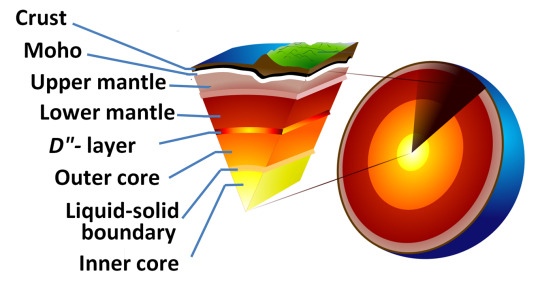
The upper mantle gets to temperatures comparable to those of lava, however due to the great pressure it is under, the rock remains solid. So, how can melt rock if pressure prevents melting? Lessen the pressure but keep the temperature unchanged. We use geothermal gradients to determine just where that point is.
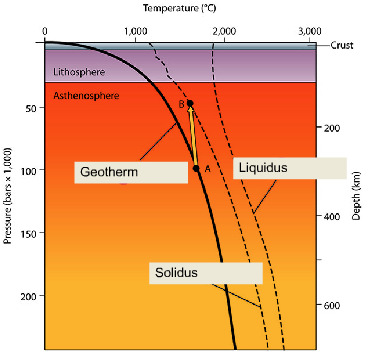
The geotherm is the temperature as a function of depth. The solidus represents conditions at which rock starts to melt and the liquidus represents the conditions at which rock completely melts. What this graph shows from point A to point B, the pressure decreases a lot but only cools a little. We call this decompression melting.
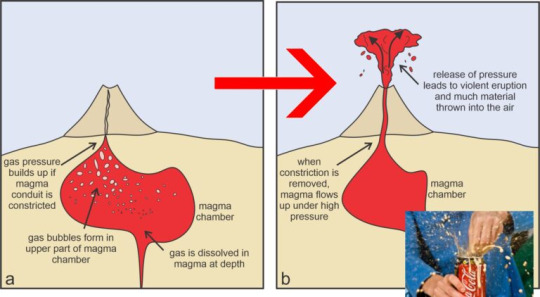
Another way rock can melt is through the addition of volatiles. Volatiles are substances that evaporate easily and can exist as gases at Earth surface pressures. Typically, these are water or carbon dioxide. This will drop the melting temperature of the hot, dry rock. We sometimes call this flux melting.
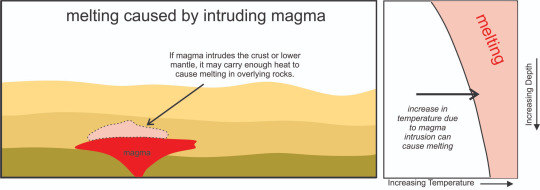
The third way to melt rock is to inject hot magma into the crust. If it has enough heat, it will raise the temperature of the surrounding rock which may be just enough to melt part of it. Thing hot fudge in ice cream. We call this heat-transfer melting.
Now that we have the how, let's learn about the composition. What is magma made out of? Lots of elements actually. Silica is a big portion. Silica is made of silicon-oxygen tetrahedrons.
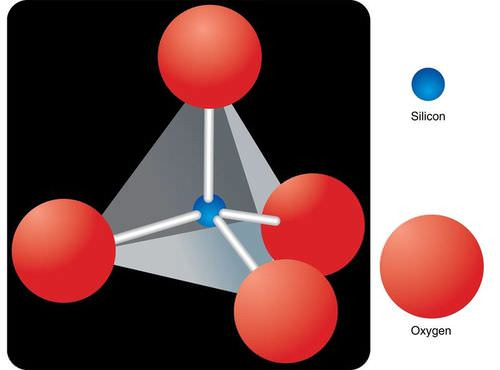
There are also other elements such as aluminum, calcium, sodium, magnesium, and iron. If it is a "wet magma" it will also contain elements that form volatiles such as water, carbon dioxide, sulfur dioxide, nitrogen, and hydrogen. "Dry magmas" do not contain volatiles.
There are four major types of magma based on the amount of silica present. These are ultramafic, mafic, intermediate, and felsic.
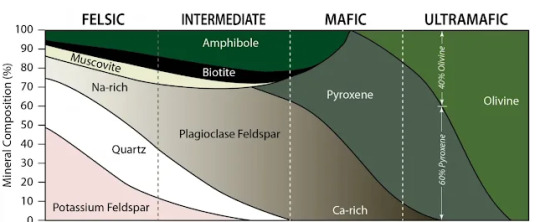
Ultramafic magmas have almost no silica in them. They are primarily made of olivine and pyroxenes, ferromagnesium minerals. Some will have a little bit of calcium-rich plagioclase.
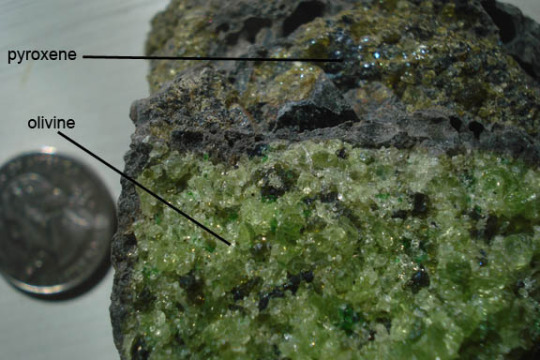
Mafic rocks start to lose the high olivine content and add other minerals like amphiboles and biotite as well as a mixture of calcium and sodium-rich plag. Ultramafic and mafic rocks tend to be very dark in color. This magma has a low viscosity and flows easily.
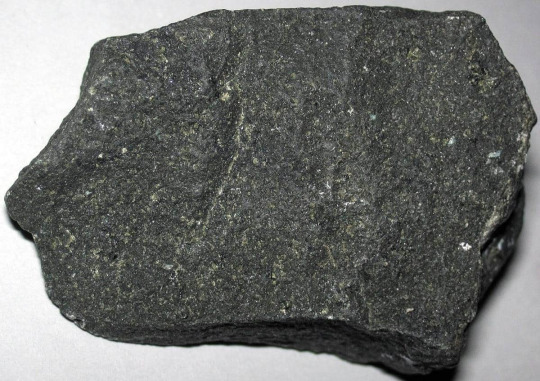
Intermediate igneous rocks typically contain between 52% and 63% silica content. Here we lose olivine completely and add quartz and k-spar as well as increasing the amount of sodium-rich plag, biotite, and amphiboles while decreasing the amount of pyroxene. Here we start to add muscovite as well. The color also tends to be a mix of light and dark minerals.
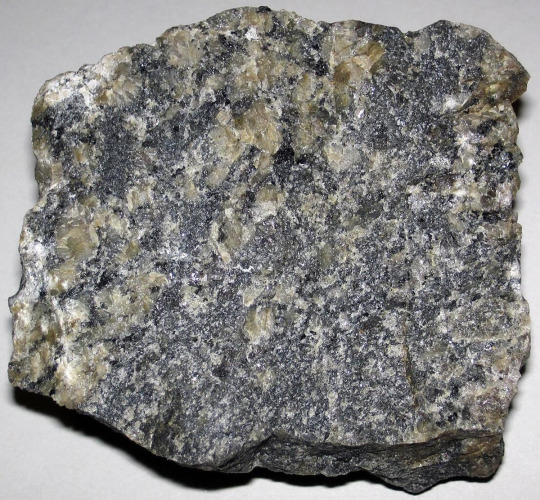
Finally, we have felsic rocks which contain more than 65% silica content. They are primarily made of quartz, k-spar, and sodium-rich plag. There are also smaller amounts of mica (muscovite and biotite) and amphibole. These igneous rocks are light in color. They are also highly viscous and resistant to flow.
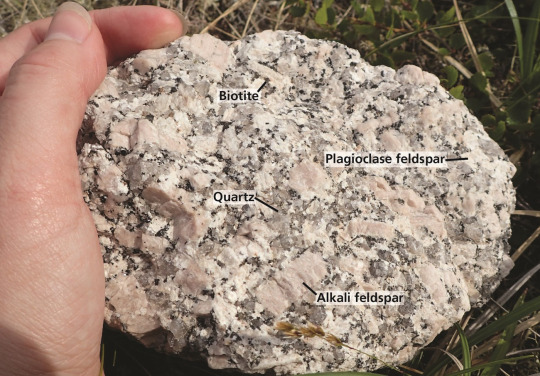
Today's lesson is now at an end but make sure you tune in tomorrow for some trivia! Fossilize you later!

#fun facts#geology#science#science education#mineralogy#igneous rock#magma#magma composition#mafic#ultramafic#felsic#how to make a rock melt#science side of tumblr#volcanology#igneous petrology
34 notes
·
View notes
Text

Everything you do for me, it's never enough.
Perspective and background practice :) / Song I got inspired of was "Moon girl" by Temachii
#rise donnie#rise of the tmnt#rottmnt#donnie tmnt#rottmnt donnie#tmnt#tmnt fanart#hi tumblr#rise donatello#tmnt donatello#forest#scenery#magma art#trees#composition#lighting#somber#perspective#practice#trees and forests#grass#magma doodles#magma.com#zzz
31 notes
·
View notes
Text
love actually doing research and reading journals but i hate that they impose a word limit for me. why do you want to cap my findings. let me talk about volcanoes at you for a few hundred more words
#cerulesen.txt#i love reading specific journals and articles abt mt fuji's relation to modern religion & formation over time#like how it's generally regarded to have happened in 3-4 'phases' and how each phase is different due to the magma composition#bc you know. chemical composition changes over time as more minerals assimilate into the magma chamber#and when magma erupts into lava the cooling will build a foundation for a whole new mountain#let me talk!! about it!! i can't keep this paper under a few hundred words
5 notes
·
View notes
Text
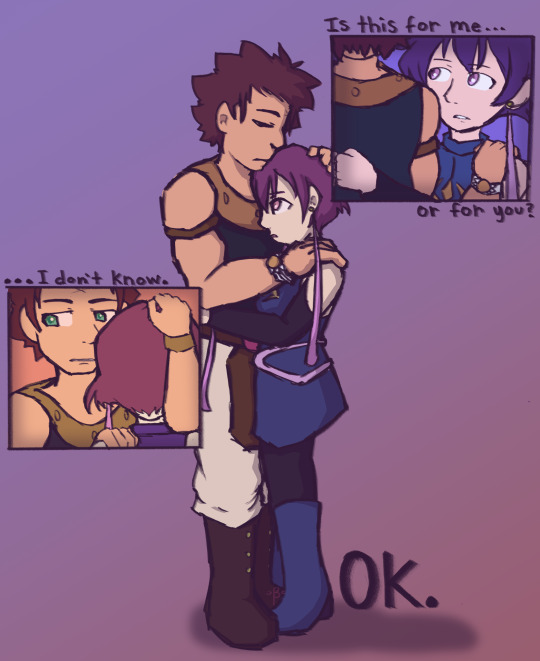
On Reconciliation
#spider riders#aqune#feels so awesome to be drawing more fleshed out compositions abt this series again#but also horrifying because like well i promise this isnt ship art we're not ready for that discussion yet#however i have given myself a lot of time to think abt Them and well. driving myself just a little bit insane#i ideally wanted to make a more comic kind of companion piece to add next to this and make it a bit more obviously#yk. about working out pre-existing tensions and actually getting to understand one another (to at least some capacity)#but. well. i dont make art often enough to really justify that and im still really happy with this as is..#also i say this every other time but the central piece here is probably one of my better/best magmas so Yippie :) i love him
5 notes
·
View notes
Text
Polti-Visit Malta est au Giro 2025 avec une nouvelle déco pour ses vélos !
L’équipe d’Alberto Contador et Ivan Basso est au départ du Giro 2025. Et pour l’occasion les Aurum Magma de Polti-Visit Malta adoptent une nouvelle décoration Volcanic ! À l’occasion du Giro 2025, les vélos Aurum Magma du Team Polti-Visit Malta seront pas rouge comme d’habitude mais Volcanic. un bon moyen de marquer les esprits pour cette participation au Tour d’Italie. Ce coloris Volcanic…
#Alberto Contador#Aurum#Aurum Magma#Cyclisme#Cyclisme Pro#Cyclosport#elite bike training#Enve composite#Garmin#Giro d&039;Italia 2025#Ivan Basso#Polti-Visit Malta#Tour d&039;Italie 2025#Vittoria tires
0 notes
Text
hey guys guess what happened
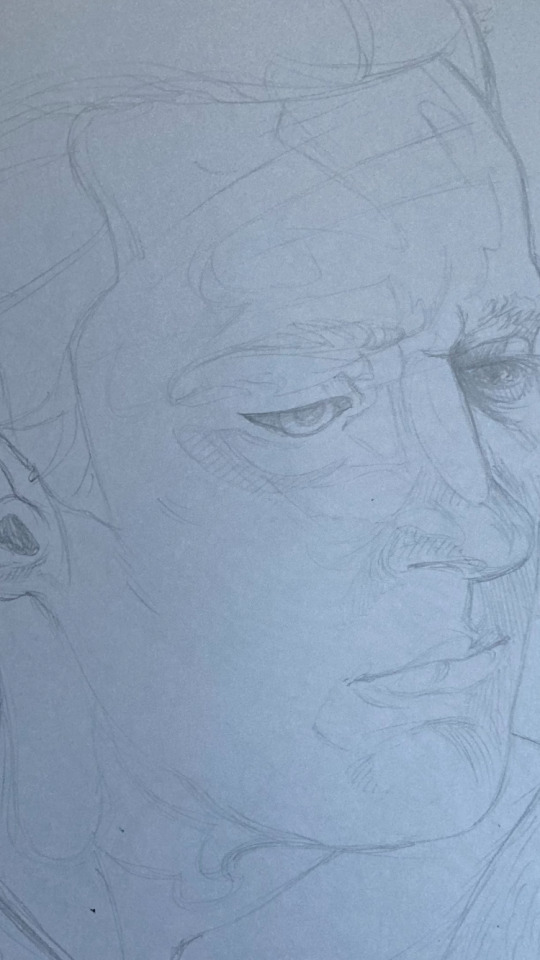
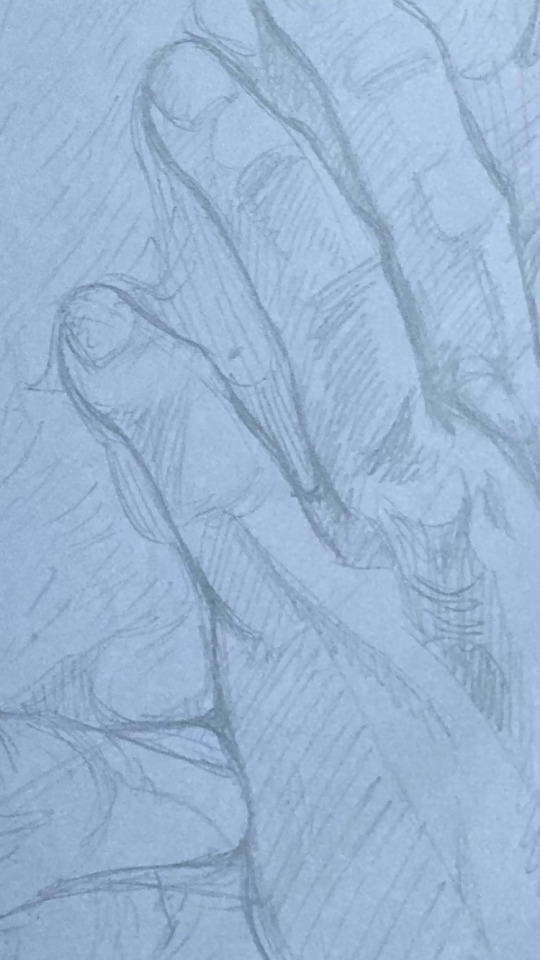
wip sketch shots i took of this piece bc im scared to RUIN IT im terrified....... its a very solid sketch. i was gonna oil pastel it but im getting nervous womp woooomp. hard to be sure of myself lately when one day i can be killing it and the next i'm a frail husk
#i ruined it#i got so angry i took an edible hoping id have some grand revelation to help fix it but now im just angry and high#the paper most certainly is not made for it but im gonna go over it in acrylic bc the composition is too promising to scrap or redo#worst case scenario i digitize it and finish it on magma
37 notes
·
View notes
Text
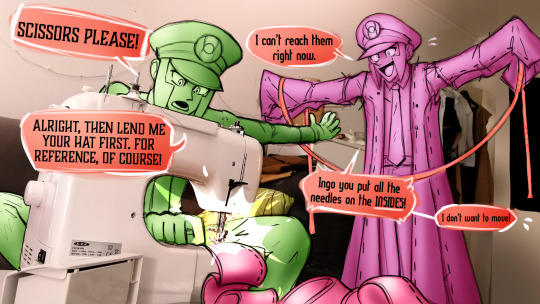
Sketch dump! Vol. 5
September 2022 (Part 1/2)
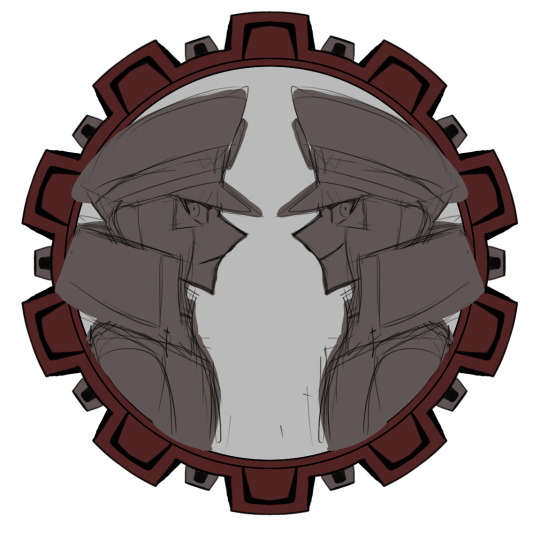
The first piece on top summarised my cosplay rush for Tracon 2022! The second is an old idea for a charm.
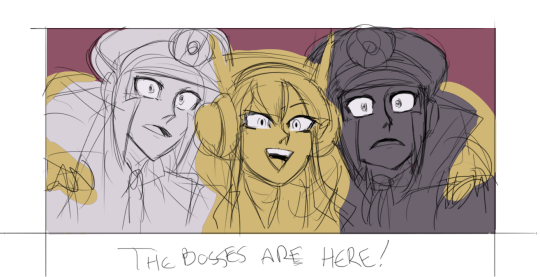
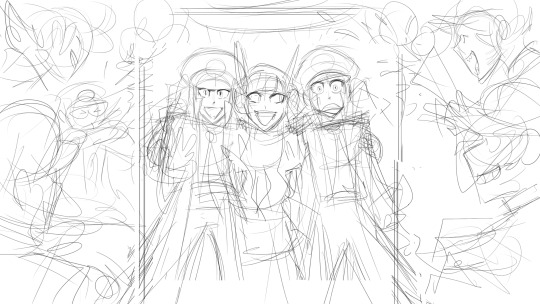
"SURPRISE!!"
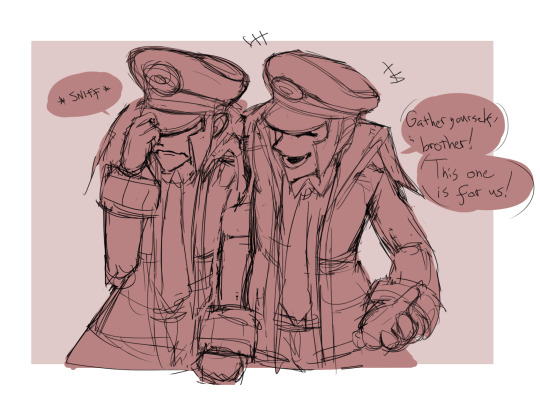
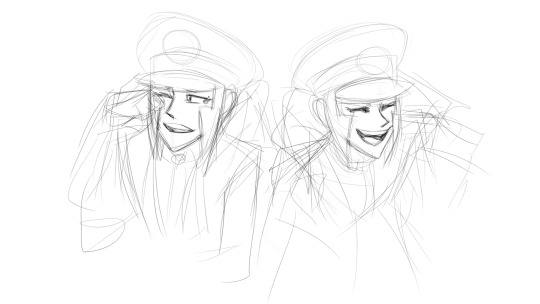
Back in 2022 I hosted an art raffle for reaching 777 followers on Twitter! The winner would get their submas themed idea realised (which was their friends throwing a surprise party for the twins!). I wanted to make a little comic and have the bosses walk in their office where depot agents, Elesa, Drayden, Skyla, Clay etc. would be waiting with decorations and treats and games.
Emmet is all smiles of course while Ingo gets so emotional he could only whisper a "super bravo".


Not really headcanons anymore but still funny ideas.
1. Emmet gets clumsy when off-rhythm! He starts walking in curves if there is nobody else around to match his rhythm with.
2. Emmet spaces out/forgets to say things aloud when someone speaks too long or when things go off-script! His thinking gets interrupted easily.
3. Ingo sometimes bumps into doors because he is too used to automatic doors!
4. When things go off-script Ingo speaks too much and rushes in straight lines"
Also my little inexpensive sketchbook & my trusty tools! Mechanical pencil and eraser pen are life when scribbling my skrimblos smaller than a postage stamp!
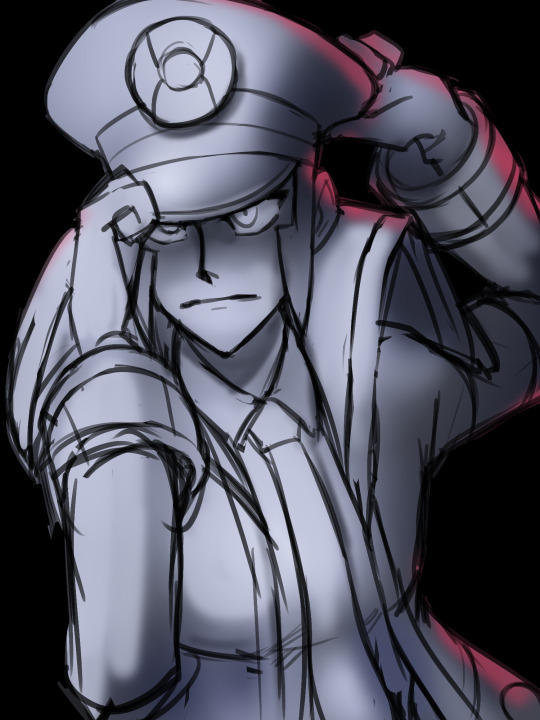
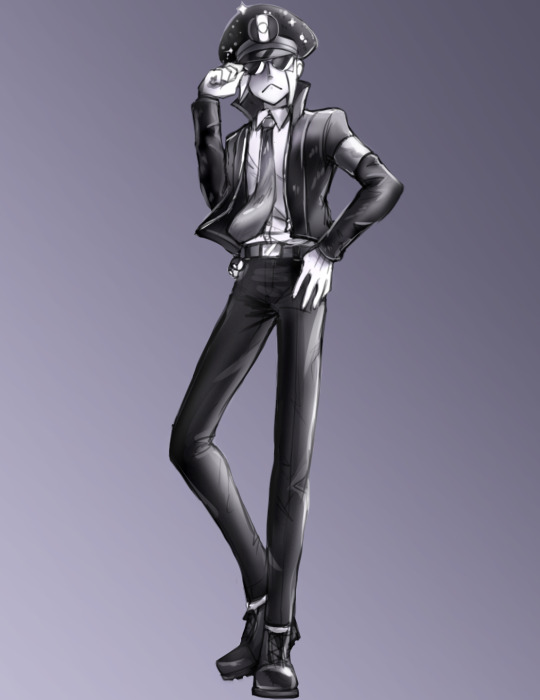
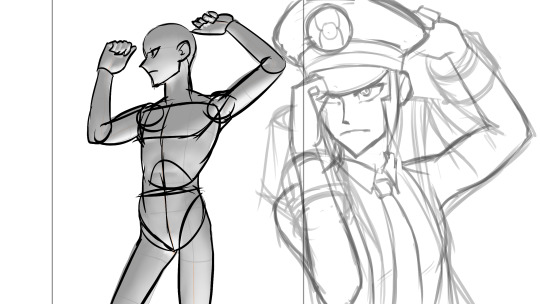
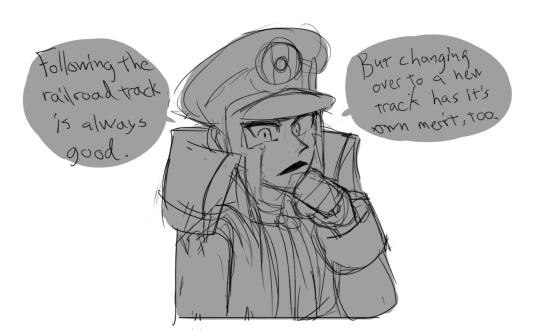
More Ingo~ I utilise a wide range of sources for references, including CSP's poseable 3D models, they can come really handy with perspectives and proportions!
The second piece is my very first attempt at cosplay in Tracon 2022: Blingo! I walked in with a sequin hat, leather jacket, leather pants and high heel patent leather boots.
The hardest part of cosplaying Ingo is remembering NOT to smile ahaha!
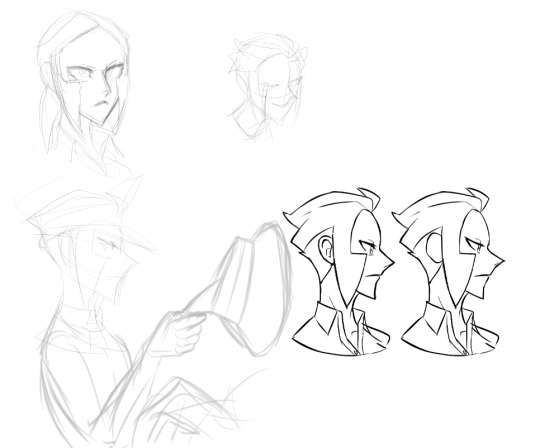
Some hairstyle tests
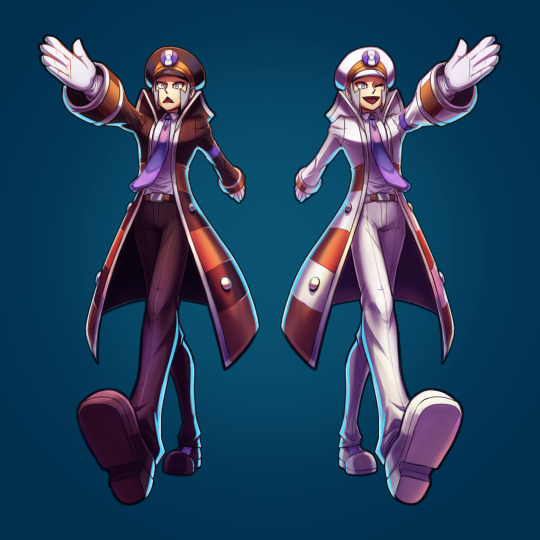
I drew these for a huge submas art collaboration over Twitter hosted by @/mimizukeii!! It was technically my first art collab before I started arranging them myself with Aggie/Magma.
While looking for train related songs I found this cute nursery rhyme to go with the marching:
"Over the mountains,
Over the plains,
Over the rivers,
Here come the trains.
Carrying passengers,
Carrying mail,
Bringing their precious loads In without fail"

I wanted to compare these silly twins, planning to do something more silly with them later. Also a sketch of @/fukurow's butler designs I never finished.. The capes compliment them so well, I love them!!


Prequel to this piece! Emmet is so confident in himself he thinks Pierce wants to learn from him but is invited for a duet on the stage instead!!
Emmet has really great voice actors in Pokemas! I especially love how his english VA gives him that bri'ish/posh/sophisticated vibe while also soft and melodic! I know for SURE this VA/Emmet can sing, I can show you later!
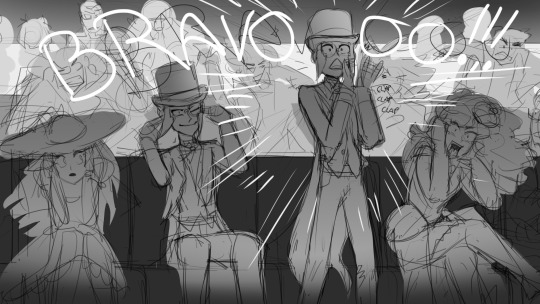
One of my favourite sketches!! I wanted to add a bunch of characters in the BG reacting to this sonic blast of emotion over a performance!
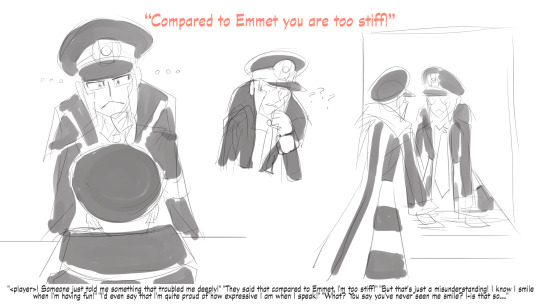
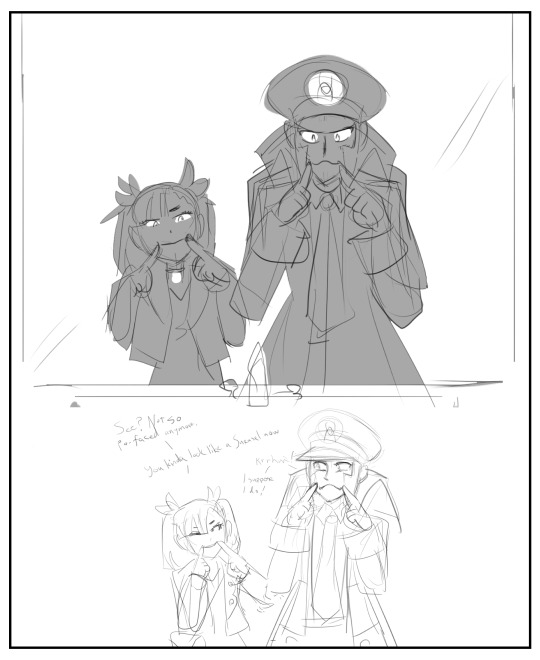
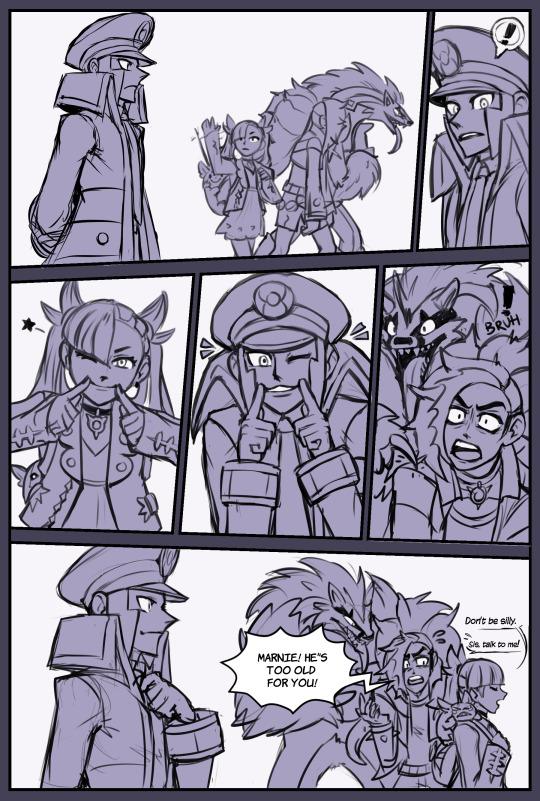
Heyyy it's the smile buddies comic!! I really hope Ingo gets to interact with Marnie in Pokemas one day!!
I feel Ingo's eyes in the mirror panel is a little off in the final comic, I meant to keep it softer like in the sketch!
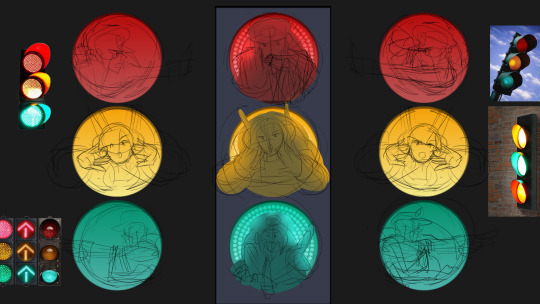
It's Nimbasa trio!! Idea inspired by submas EX uniform colors. Might continue this later!

Some BG tests for this piece! Compositing is hard but absolutely worth the effort, it can make a huge difference in the appeal of your piece!!
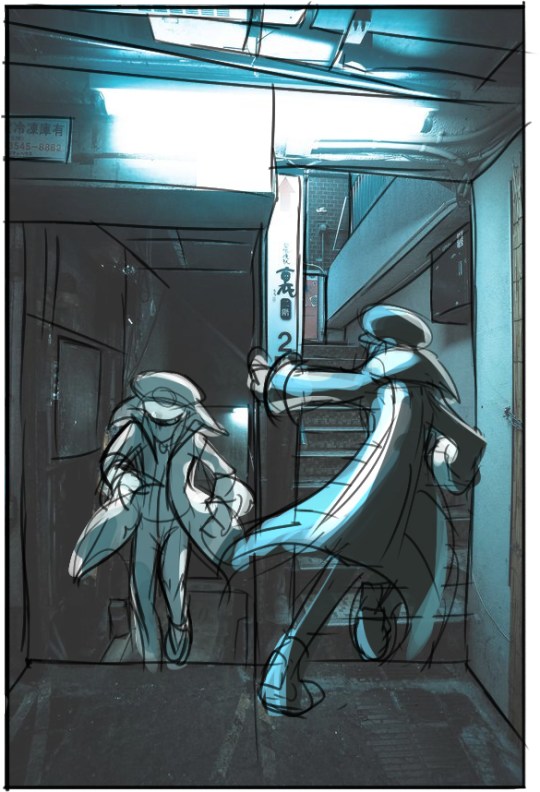
Practise piece drawing over a photo I thought was cool! I want to get more experimental with lighting and perspective!
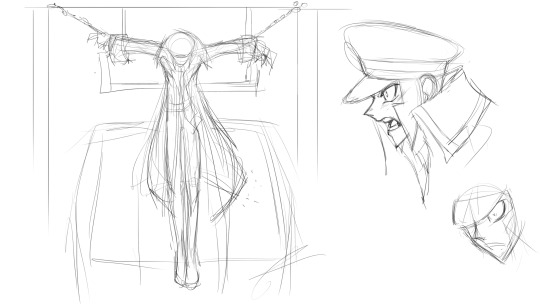
'How's it hanging bro?' Who hung him up there anyway??
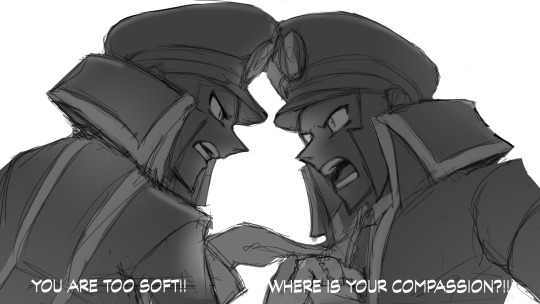
Sketch for this arguing scene! Something REALLY BAD needs to happen for them to end up that tense! Even if I want to present them close to the canon material I still want to put them in really challenging situations to see how far I can push their emotions!
Thank you so much for coming all the way down here!! This set was pretty loaded, I hope you enjoyed scrolling through all this ahah!
Previous posts:
Sketch dump Vol. 1: April-June 2022
Sketch dump Vol. 2: July 2022
Sketch dump Vol. 3: August 2022
Sketch dump Vol. 4: July 2022 Part 2
#submas#subway boss ingo#pokemon ingo#submas ingo#subway boss emmet#pokemon emmet#submas emmet#submas butlers#butlermas#pokemon#sketch dump#pokemon elesa#nimbasa trio#excadrill#archeops#eelektross#sordward#shielbert#cosplay struggles#breakmas#team break submas#my comics
735 notes
·
View notes
Text

What are orbicules? This piece of granite comes from the Yilgarn Craton in Western Australia, an ancient piece of continental crust that began forming about 2.7 billion years ago. It’s one of the oldest enduring landmasses on Earth. Orbicules are the unusual ball-shaped, radial clusters of crystals that you can see on this rock. The diversity in the orbicules’ mineral composition and structure indicate that the conditions in the magma changed as they grew. See this specimen and more than 5,000 others in the Mignone Halls of Gems and Minerals. We're open daily from 10 am–5:30 pm! Plan your visit.
Photo: © AMNH
#science#amnh#museum#nature#natural history#fact of the day#did you know#word of the day#orbicules#gems#minerals#rocks#geology#earth science#museum of natural history#natural history museum#granite
611 notes
·
View notes
Text
What is a Rock?
Hey folks!
Before we get started with sharing our full survey notes, we thought it would be a good idea to go over some basic terminology to ensure we're all on the same page!
What is a Rock?
No, seriously! What counts as a “rock”? Geologically speaking, a rock is a solid, naturally-occurring collection of minerals. It might be made of a single mineral type, or multiple, but it is an aggregate of many individual mineral crystals that are interlocked together.

Fig. 1: An image of a coarse-grained granite showing individual crystals of feldspar, mica and quartz. Note that the entire rock is made up of these interlocking crystals.
What is a Mineral?
Okay, so we know what a rock is now - it's made up of minerals. But, what is a mineral? A mineral is a building component of rocks, and they have a very specific definition based on particular criteria that must be met. For something to be considered a mineral, it must meet all the following criteria:-
It must be solid
It must be naturally-occurring
It must be inorganic
It must have a definite and known chemical composition
It must have a defined crystal structure
What does this actually mean? Let’s walk through it. Criterion one discounts anything that is a liquid - such as water. As you know, rocks and minerals can become liquid when exposed to high temperatures, magma and lava for example, but in this form, they are not minerals, and therefore not rocks! They can only be classed as minerals once they solidify, provided they meet the other criteria alongside.

Fig. 2: Image of lava (a non-mineral due to its liquid form) and basalt (a fine grained, igneous rock, and the solidified form of many low viscosity lava flows).
As for the other criteria, naturally-occurring and inorganic are self-explanatory. No crystals that can only be manufactured in a laboratory setting are true minerals, because they cannot exist in nature! Crystals that are commonly lab-grown but can exist in nature (such as moissanite) still count as minerals. Inorganic means the mineral can be formed by inorganic processes. Something like calcite can be produced by animals (such as clam shells) but can also be formed by geological processes without the involvement of any living thing. This actually discounts amber as a mineral - since it is tree resin (formed organically) and is not replaced by any other minerals as is the case with fossilisation - therefore amber is not a mineral!
Having a definite chemical composition is also pretty much what it sounds like - it needs to have a chemical formula - a sequence of elements organized to form a compound that we know the definite composition of. For example, the chemical composition of quartz is SiO₂, which means it is a compound made up of atoms of silica and oxygen. Similarly, the composition of potassium feldspar - KAlSi₃O₈ is made up of potassium, aluminium, silica and oxygen atoms. When dealing with specific types of rocks, such as fine grained igneous specimens, the fine grain size of the individual crystals often makes it impractical to determine rock type via crystal analysis alone, so some geologists will use chemical analysis to aid in this - hence why it's important to know the definite chemical composition of your specimens!
Lastly, a mineral must have a crystal structure - but what is a crystal structure? The simplest way to imagine this is with building blocks. Each block is the unit that defines the chemical composition - for example, SiO₄ for quartz. So, one “block” of quartz will be a unit of SiO₄. By arranging these blocks in a repeating pattern, a larger structure begins to take form. Crystals are naturally orderly structures - imagine the blocks are piled nicely on top of each other, this is why many crystals have such well defined shapes!

Fig. 3: Diagram showing the atomic "building block" structure of quartz using a 3D model and ball-and-stick diagram; diagram showing "building blocks" arranged in the natural crystal structure; image of a quartz crystal - note the same crystal structure!
Something like glass, or a naturally-occurring glass, like obsidian, has these blocks arranged randomly, like if you were to take your tower and throw it into a storage bin. Because obsidian lacks this order on an atomic level, it isn’t considered a true mineral!

Fig. 4: Image showing a fragment of obsidian. Note the conchoidal fracturing on the obsidian - this is caused by the lack of organisation in its structure. The disorganised nature of natural glass and obsidian exclude them from being a true crystal, and therefore they are also not considered true minerals.
Unfortunately, we aren’t going to be able to run any chemical analyses in Outer Wilds, but we’ll do our best to compare what we see to real-world rocks, minerals, and features, and hopefully this will be able to steer us in the correct direction regarding some of these criteria to ensure we are making the most scientifically informed analyses possible!
What is a Fossil?
Now, we just said that minerals and rocks can’t be organic, and you’re probably thinking, well hold on a second, what about fossils? How can something that was organic become inorganic, and then a rock?
Let’s start by defining what a fossil actually is. Fossils are described as “any preserved remains, or trace of a once-living thing from a past geological age.” This includes anything from the fossilised skeletons of dinosaurs, to the delicate imprints of leaves and plants. Now, it’s important to note that not all fossils are rocks. Objects preserved in amber, for example, are classed as fossils - but as they remain organic they cannot be classed as a rock.
How do we go from something organic, like a bone, to an inorganic version of it? Probably the most well known form of fossilisation is via replacement - where organic remains are replaced by inorganic minerals. Most bones are made up of calcium phosphate and other organic materials. When an animal dies and is buried by sediment, these organic materials are replaced by inorganic crystals in a process known as permineralisation. Permineralisation occurs when the pores of the original specimen are infilled with mineral matter from the ground or water - which then, bit by bit, replace the original organics with minerals, eventually completely replacing the whole specimen! When this occurs, you no longer have your original animal bone, but instead a replica of it with a completely inorganic composition - a fossil! The minerals involved in replacement can vary widely, which can produce spectacular finds such as these pyritised ammonites, or opalised vertebrae!

Fig. 5: Fossilised remains of two opalised Iguanodon vertebrae; a pyritised Ammonite.
Other fossils, such as footprints and burrows provide a record of an organism’s life, as opposed to actual remains of the organism itself. These fossils are known as trace fossils and are normally impressions that have been made in soft mud/soil that has then lithified. The cool thing about trace fossils, and especially footprints, is that you’re left with a cast of whatever part of the creature made contact with the substrate - sometimes with incredible detail of footpads, claws, and/or skin. Other trace fossils include things like coprolites, gizzard stones, and nests! A trace fossil is also completely inorganic, as it’s simply an imprint of a creature, or something a creature left behind, and as such, technically classes as a rock!

Fig. 6: Photograph showing a dinosaur footprint mould and a dinosaur footprint cast. Both of these are trace fossils and have been formed via sediment infilling and lithification.
Alright, there was a lot of information there, but hopefully it has provided you with a strong foundation and understanding of what classes as a true rock! In our next post, we will be diving into the different rock types and the funky structures and features that they can create!
Hopefully, you’ll soon be able to start identifying a variety of rocks in your own Outer Wilds adventures!
If you have any questions regarding what we have talked about here, or indeed just about the Outer Wilds Geological Survey in general, please don't hesitate to drop us an ask!
Catch you in the next loop! The OWGS Team
71 notes
·
View notes
Text

jobert closeup btw
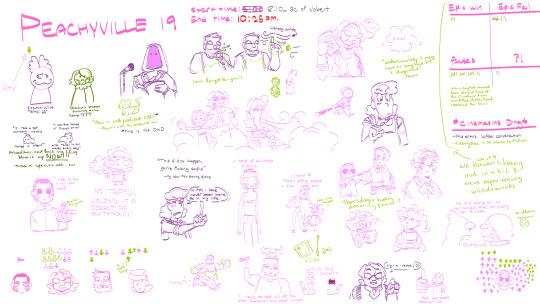
god tried to stop us from listening to this together but @draconicdetective and i persevered
#hi look at the only consistent thing i post ok#i would love to wonder for anyone who reads our magma-alongs what order you read these things in#because if you try to take it as a whole composition its kind of the worst thing youve ever seenn#so i would love to know#this is my art btw
16 notes
·
View notes
Text
OC Ideas: List of Quirks!
(BNHA)
Quirk Ideas below the cut <3
This is essentially just a huge, not really filtered list of ideas so please don’t take it… Too seriously lmao.
OC QUIRK IDEAS!
Acid Cure - The user has sharp fangs filled with a poison that can heal when injected.
Animorph - The user can transform into any animal they have physically seen and been in the proximity of for one minute.
Black Void - The user can summon a void that contains horror-like creatures and objects.
Chains - The user can produce chains made from the iron in their body.
Claws - The user’s hands are razor-sharp claws.
Command - Others will obey any order the user gives from speech.
Conceal - The user can turn themselves and anything they touch, like clothes, invisible; and can turn others invisible as long as the user is in physical contact with them.
Dark Matter - The user can manipulate indetectable matter and form it into void-like weapons.
Dreamwalker - The user can walk in the dreams of anyone they have seen.
Dust - The user can manipulate dust in the air.
Face Shift - The user is able to manipulate their body and face to be a new, nonexistent person.
False Truth - Any lie the user tells will be believed.
Fear Eyes - The user’s stare can incite hallucinations in another of their darkest fears.
Flaming Skin - The user’s body radiates a deadly heat in which anything the user touches will burst into flame.
Fusion - The user can fuse two individuals to create a whole new person for up to an hour. The two minds may clash, however—and the quirks are combined into just one new one.
Gravity Well - The user can create localized gravity wells, pulling objects or people towards a single point. The strength and range of the gravity well depend on the user's focus.
Hallucination - The user can create illusions that disappear when touched.
Healing Hair - The user’s hair can heal almost any injury.
Identity - The user can transform into any living person they have touched before for up to thirty minutes.
Interface - The user can control and manipulate machines and electronics by interfacing with them mentally, allowing them to hack devices, control robots, or operate advanced technology without physically touching it.
Lava Lamp - Parts of the user’s body have the characteristics of a lava lamp.
Light and Dark - The user can generate light when experiencing positive emotions and darkness when experiencing negativity.
Liquid Composition - The user can transform into semi-solidified water to move around.
Magma - Part of the user’s body is composed of lava that is generated.
Matter Hair - The user can change the composition of their hair to be any reasonable solid element on the periodic table.
Metallic Grip - The user can turn their arm and leg composition into any (reasonable) metal in existence.
Mitosis - The user can split themselves into two people, themself and a distinct, separate person, like an alter ego, that they also control. More splits may occur, resulting in different individuals.
Photosynthesis - The user has the properties of a plant.
Polyglot - The user is able to speak, read, and write every language they hear spoken or see written.
Prosper - Since developing this quirk, the user is unable to age and stays the physical age of five.
Shadow Beasts - The user can transform darkness into solid, shadow beasts.
Shadow Body - The user can turn themselves into a cloud of shadow and can manipulate shadows around them, turning them into solid objects.
Sharp Wings - The user has wings made of a razor-sharp steel that can cut through almost anything.
Siren’s Call - The user’s singing voice incites a burning rage in others, causing mayhem and destruction.
Size Shift - The user can shrink down to 1/50 times their normal size or grow up to 50 times their normal size in a range.
Slime - The user can create a corrosive, jelly-like substance from their hair.
Spindle/Marionette - The user can spin silk from their wrists. As a unique touch, these strings can wrap around living beings and influence their body completely—movement control, as though people are puppets.
Spines - The user has large, shark-tooth-like spines on their arms, legs, sides, and head.
Stare-way to Hell - The user’s stare can ignite objects or people on fire if the user is angry enough.
String of Fate - The user can know the location of anyone they have seen and fallen in love with.
Succubus - The user’s presence causes others to become enchanted by them. They also have the features of a succubus or incubus.
Toxic Blood - The user’s blood is rich with a deadly poison that can kill when ingested by someone else.
Vampire - The user has superhuman strength, speed, and beauty with the ability to captivate others at will, but has to drink blood in order to keep their abilities and to live and can not go out in the sun.
Virus - The user can grow tendrils from their body and stab them into others, which enables the victims to be dazed and in shock for up to fifteen minutes and use part of the same quirk, inflicting others.
Werewolf - The user can transform into a wolf-like creature.
#bnha imagines#oc imagines#my hero academia imagines#mha imagines#mha#bnha#bnha oc#mha oc#my hero academia ideas#MHA ideas#bnha ideas#imagines#ocs#oc rp#oc inspo#oc info#oc insert#oc inspiration#bnha quirks#mha quirks#original quirk#quirk ideas
145 notes
·
View notes
Text
Trivia Tuesday!
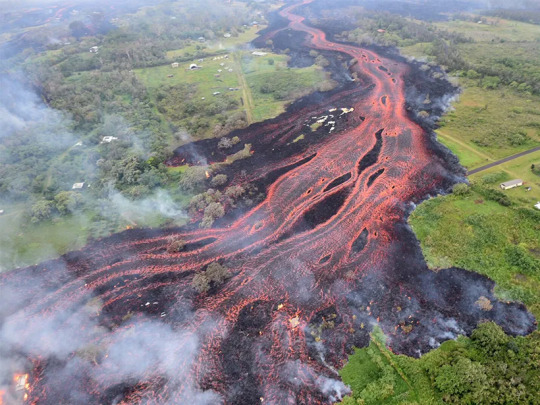
Thank you for participating in this trivia and tune in later this evening to see if you got the answer right. Fossilize you later!

11 notes
·
View notes
Text
There is a volcano outside my hometown, looking very rumbly and explody, (very scientific geomorphologic terms there) and people are all upset and nervy about it.
So what I'm wondering is if my blase attitude is a result of too much geo knowledge or like, overly chill nihilism. Because I read an article about common questions and concerns and the whole thing came off as vaguely funny to me. It was just increasingly breathless far fetched excuses for panic, like, 'is this eruption gonna be as bad as it mt st Helen's?' And the answer is no, that's a different mountain with different composition and different magma structures and also the only other volcano you've ever heard of. It's not gonna be like Vesuvius and Pompeii either. And it's not gonna be like a Hawaiian volcano. Or Yellowstone. Those are different. It will be very similar to the volcanos on either side of it, which have both gone off several times in recent memory. This isn't a new thing.
The mountain will either go off or not and there is nothing you can do about it. It will impact air quality and not much else. It's its real bad it might shut down the airport. (Which is actually pretty bad, it's the 2nd largest cargo hub in the states) There's nothing you can do about that either.
Sometimes you gotta weather the storm and fussing over drizzle just gets annoying.
79 notes
·
View notes
Note
hii I love your stuff can you make writing notes about volcanoes I wanted to write abt them for my writing project and I'm having a hard time on in thx ^^
Writing Notes: Volcanoes
Volcano - vent in the crust of Earth or another planet or satellite, from which issue eruptions of molten rock, hot rock fragments, and hot gases.
Volcanoes are Earth's geologic architects.
They've created more than 80 percent of our planet's surface, laying the foundation that has allowed life to thrive.
Their explosive force crafts mountains as well as craters.
Lava rivers spread into bleak landscapes.
But as time ticks by, the elements break down these volcanic rocks, liberating nutrients from their stony prisons and creating remarkably fertile soils that have allowed civilizations to flourish.
Some 75% of the world's active volcanoes are positioned around the ring of fire.
It is a 25,000-mile long, horseshoe-shaped zone that stretches from the southern tip of South America across the West Coast of North America, through the Bering Sea to Japan, and on to New Zealand.
This region is where the edges of the Pacific and Nazca plates butt up against an array of other tectonic plates.
Importantly, however, the volcanoes of the ring aren't geologically connected.
In other words, a volcanic eruption in Indonesia is not related to one in Alaska, and it could not stir the infamous Yellowstone supervolcano.
Active – volcanoes known to have erupted during historical times. (Total Number = 529)
Dormant – volcanoes that have not erupted during historical times, but will probably erupt again. (Total Number = 1,340)
Extinct – volcanoes that are unlikely to erupt again.
The 3 Classic Types of Volcanoes
TYPE — SIZE — LIFESPAN
Cinder Cone — Small (<1,000 ft; 330 m tall) — Short (single eruption of a few months)
Composite Volcano — Large (usually between 6,500 and 20,000 ft; 2,000-3,000 m tall) — Long (hundreds of thousands of years)
Shield Volcano — Very large (up to a maximum of 33,000 ft; 10,000 m tall) — Very long (up to a million years or longer)
Different shapes of volcanoes have different kinds of eruptions.
The most explosive eruptions come from stratovolcanoes, like the Augustine Volcano in Alaska. When they erupt, stratovolcanoes blow huge columns of gas and ash into the air that can collapse in hot, fast-moving clouds called pyroclastic flows.
A shield volcano, like Mauna Kea in Hawaii, has gentle slopes formed by oozing, runny lava. The magma is low in silica and low in gas, so it doesn’t erupt explosively.
A lava dome, like the one of Chaitén Volcano in Chile, forms when thick lava oozes from a vent, piles up, and cools into a steep mound. The lava is thick because it’s high in silica, and it oozes instead of explodes because it’s low in gas. Sometimes lava domes form after explosive eruptions.
A cinder cone volcano, like Tavurvur in Papua New Guinea, forms when erupted fragments harden and fall to the ground, accumulating around the vent in a cone shape. The lava is low in silica, so the lava is runny. High gas levels make for the explosive eruptions that send it flying. Cinder cones typically form at the beginning of eruptions, and lava flow follows.
Olympus Mons - a giant shield volcano on Mars. It is believed to be the largest volcano in the solar system. The entire island of Hawaii would fit in its caldera.
In more-detailed classification schemes based on character of eruption, volcanic activity and volcanic areas are commonly divided into 6 major types, shown schematically in the diagram. They are listed as follows in order of increasing degree of explosiveness:
Icelandic
Hawaiian
Strombolian
Vulcanian
Pelean
Plinian
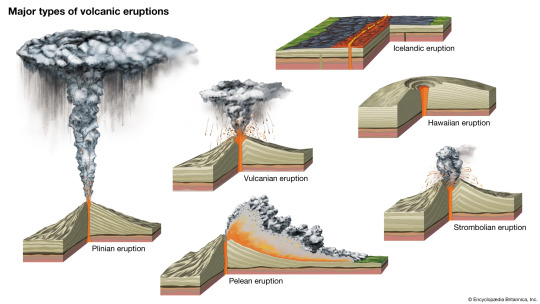
There are different types of volcanic eruptive events, including:
pyroclastic explosions, with is fast-moving hot gas and volcanic matter
hot ash releases
lava flows
gas emissions
glowing avalanches, when gas and ashes release.
Volcanic eruptions can also cause secondary events, such as floods, landslides and mudslides, if there are accompanying rain, snow or melting ice.
Hot ashes can also start wildfires.
Volcanic eruptions can impact climate change through emitting volcanic gases like sulfur dioxide, which causes global cooling, and volcanic carbon dioxide, which has the potential to promote global warming.
Features and Erupted Material
Viscosity: The resistance of a material (usually a fluid) to flow. Example of comparison would be the higher resistance to flow of cake batter compared to water.
Lava Flow: Lava flow is thin at the top of the cone, while lava pooled at the base is very thick. When eruptions end, erosion processes start on the cooled lava, including glacier erosion, flowing water, rockfall, and landslides. The volcano will only grow in size if the amount/volume of lava erupted is more than the amount that is lost to erosion.
Volcanic Gases: Most gases originate in the mantle and are transported to the crust and surface by complex interactions with magma and rocks along the way. In general, gases are dissolved in the magma. At shallow depths, as pressure on the magma decreases, gases leave the magma. The gases can interact with surrounding rocks or continue to the surface. The most common volcanic gases are: Water Vapor (H2O), Carbon Dioxide (CO2), and Sulfur Dioxide (SO2). Gases can be both dissolved in the magma chamber and also emitted from volcanoes at the surface. It’s the dissolved gases cause volcanoes to erupt.
A magma chamber contains high pressure and dissolved gases.
The density contrast between the magma and the surrounding rock causes more buoyant magma to rise. As the magma rises, the dissolved gases start to come out of the liquid and form bubbles.
As the bubbles grow and increase in volume, it causes the magma to became more buoyant and ascend closer to the surface, allowing the overlying pressure to decrease and produce magmatic foam.
When the pressure in the bubbles is greater than the pressure of the overlying rock, then the chamber will burst causing a volcanic eruption.
The viscosity, temperature and composition of the magma determine whether the explosion is explosive or effusive.
More Features and Erupted Material
Silica: Influences lava viscosity and overall shape of the volcano. Silica molecules form a strong bond that permits entrapment of volcanic gases and promotes explosive volcanic eruptions. Low-silican magmas allow rapid escape of gases and low-explosivity eruptions. Other factors that control magma viscosity include the temperature, gas, water content and the amount of crystals in the magma.
Color: Color and texture of lava vary considerably depending on cooling conditions. Lava rocks at high temperatures appear red to orange in color but cool quickly to shades of red (due to oxidation) and gray.
Sound: Witnesses of slow-moving, partially cooled lava flows report sounds similar to breaking of glass and pottery, caused by the splintering of the cooled outer skin of the lava flow. In contrast, the passing of a pyroclastic flow is eerily quiet. Some people say this is because its sound energy is absorbed within the billowing ash cloud.
Smell: Observers of lava flows report a slight sulfur smell in the air and the odor of burning vegetation.
Texture: Lava at Mount Rainier is not as fluid as lava at the volcanoes on Hawai'i, where lava flows sometimes resemble hot molasses, nor is it as viscous as lava at Mount St. Helens.
Tephra: Fragmental material produced by a volcanic eruption regardless of composition, fragment size or emplacement mechanism. Also referred to as pyroclasms (airborne), and pyroclastic flows (on ground) and rocks. Tephra can stay in the stratosphere for days to weeks following an eruption. It can also reflect light and heat from the sun back into the atmosphere. Tephra mixed with precipitation can also be acidic and cause acidic rain and snowfall. Tephra is made up of ash (fragments of pulverized rock, minerals and volcanic glass), volcanic blocks (a mass of molten rock), and lapilli (little broken up pieces of molten or semi-molten lava ejected from eruption).
Other Types of Volcanic Rock
If a rhyolite lava flow cools quickly, it can quickly freeze into a black glassy substance called obsidian. When filled with bubbles of gas, and usually with explosive eruptions, the same lava will form pumice. If the same lave is allowed to cool slowly…it will form a light-colored, uniformly solid rock called rhyolite.
Pumice most commonly forms with rhyolite lava flows, though it has formed from dacite and andacite. flows as well. It is so lightweight, it will float on water.
Obsidian has been used for centuries in many countries for things such as weapons and art.
The shape and size of a volcano are controlled by several factors
The volume of volcanic products
The interval length between eruptions
The composition of volcanic products
The variety of volcanic eruption types
The geometry of the vent
The environment into which the volcanic products are erupted
Overall, 44 volcanoes were in continuing eruption status as of 23 December 2024.
An eruption marked as "continuing" does not always mean persistent daily activity, but indicates at least intermittent eruptive events without a break of 3 months or more.
There are typically 40-50 continuing eruptions, and out of those generally around 20 will be actively erupting on any particular day (though detailed statistics on daily activity is not usually kept).
Health concerns after a volcanic eruption include:
Infectious disease
Respiratory illness
Burns
Injuries from falls
Vehicle accidents related to the slippery, hazy conditions caused by ash
When warnings are heeded, the chances of adverse health effects from a volcanic eruption are very low.
Volcanic Ash. Exposure to ash can be harmful. Ash is gritty, abrasive, sometimes corrosive, and always unpleasant. Small ash particles can abrade (scratch) the front of the eye. Ash particles may contain crystalline silica, a material that causes a respiratory disease called silicosis.
Sources: 1 2 3 4 5 6 7 8 9 ⚜ More: References ⚜ Writing Resources PDFs
Thanks so much! Do go through the links above for more details I wasn't able to include here. Hope this helps with your writing :)
#volcano#writing reference#writeblr#literature#worldbuilding#writers on tumblr#dark academia#spilled ink#writing prompt#creative writing#writing advice#writing inspiration#light academia#writing ideas#writing resources
77 notes
·
View notes
Note


When you brought up the rock with squiggles that made me immediately go to metamorphic Rock which form due to immense heat and pressure alternating composition of the rock making these cool squiggles, the rock with a bunch of holes in it made me think of pumice which forms because of water and oxygen trapped inside of magma and forming these bubbling openings hense why it’s so light honestly pretty cool rocks, my personal favorite rocks are the fossils that form from sediment replacing dead organic matter like bone taking the shape of that organism it’s how we have found ancient animals long since extinct like those mighty trex don’t worry about encountering them btw they went extinct long before humans where kicking about. There is honestly some pretty dang cool fossils paleontologists (study of ancient life) have found creating a kind of record of life
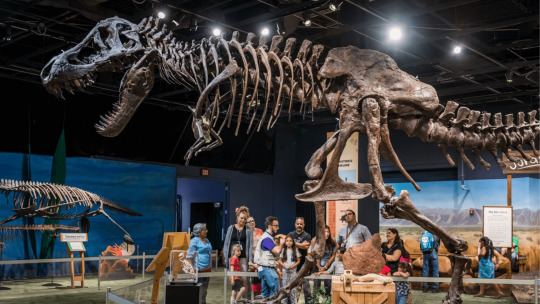
OOOOOOOO!!!!
rocks Look like the giant lizards from wasteland!
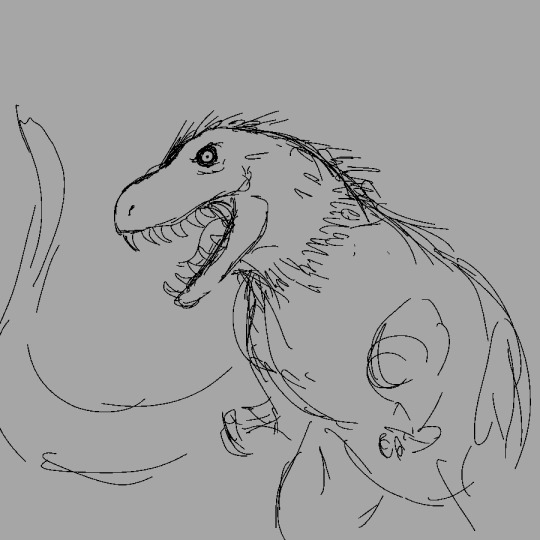
big and tall with teeth like knives!
30 notes
·
View notes
Text
Geology and the World of Cars: Part 2

Last time, we tackled metamorphic rocks. Today, we're gonna learn about igneous rocks! My favorites! Grab your aluminized suit and hug your Blade plushy, 'cause things are gonna get HOT.
Note: Any time you see information followed by an asterisk (*), it is a reference to my own, personal WOC headcanon.
Igneous rock formation is the easiest for humans to comprehend because the basic principals--melting and freezing--are very familiar to us AND happen on time scales that our silly, monkey brains can actually understand.

Behold! An igneous rock!
In all seriousness, if not for being man-made, this horrifying Spongebob popsicle could be classified as an igneous rock!
How?
Igneous rocks form from the cooling of molten rock (called magma or lava depending on whether it is underground or above ground, respectively).
Ice, believe it or not, IS an igneous rock. This is because the ice crystals that comprise it meet all the criteria to be classified as a mineral: They are naturally occurring, inorganic, crystalline solids with definite chemical compositions. To make ice, or any other igneous rock, a molten medium must be chilled to its "freezing point." Water has a freezing point of 32 Degrees F (0 degrees C). At this temperature the movement of individual water molecules is so slow that they start bonding with other water molecules into a repeating, three-dimensional lattice which we call a crystal.

As crystals continue to form and grow at the expense of the melt, they start bumping into other crystals, fusing with them along their edges. Once all the water has been used up, we're left with a solid composed of thousands of interlocking ice crystals.
Igneous rock forms in basically the same way, except that the freezing temperature of molten rock varies between 1,100 and 2,400°F (600-1,300°C)! This is why if you ever see scientists getting close to fresh lava, they wear special, heat-resistant suits that look like they'd fit in to any 1950's era science fiction motion picture.
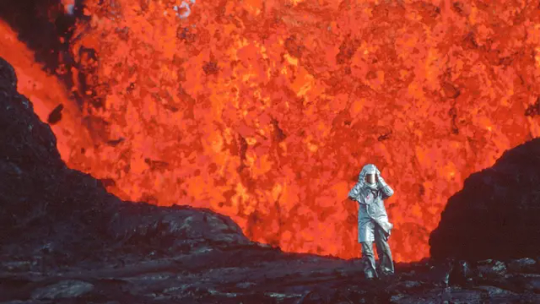
*Note* I'm not going to into the details of magmagenesis (the formation of magma)...it could be it's own article, tbh. Suffice to say that molten rock is only generated in very specific environments along very specific plate boundaries. Volcanoes are the surface expression of magmagenesis, and most of them can be found in a belt of tectonic activity that "rings" the Pacific ocean, hence it's colloquial name "The Ring of Fire." Most of y'all don't need to worry about a volcano popping up in your backyard...
Ok...so let's apply what we've learned so far to the World of Cars, starting with volcanism.
A "volcano" is a mountain created when "volcanic materials," such as ash and lava, pile up over a fissure in the Earth's crust. There are many different types of volcanoes, each with their own eruptive styles and geomorphology (aka physical traits).
The only actively erupting volcano we see in the WOC is the unnamed mountain in Cars on the Road Episode 1: Dino Park.

Lookit how 'dorbs it is! Such a cute, widdle guy....
Note the steep sides and "cone" shaped profile. This shape is characteristic of "stratovolcanoes," a family of volcanoes that are built from alternating layers ("strata") of hardened lava and "tephra" (fragmented rock of varying sizes). Normally the slopes aren't as steep as what's depicted here, though there are exceptions (Ol Doinyo Lengai, Goma, etc...). Compare this to the much more realistic depiction of Mt. Fuji--also a stratovolcano--in Cars 2.

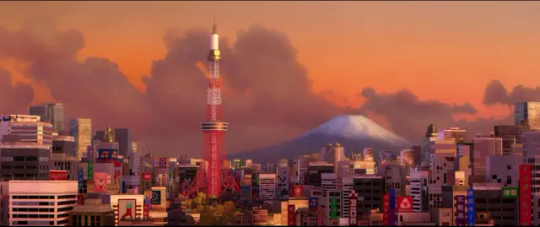
Fuji's sleek and beautiful cone was built on the remains of older volcanoes over a vast swath of geologic time (the earliest eruption on record was from 12,000 BE (Before Exodus--4.12 million years B.P.*). It warms my heart--no pun intended--that the animators really did their best to convey her size and natural beauty on the digital canvas.
Evidence of Plutonic (i.e. underground) processes: Piston Peak National Park (PPNP):
PPNP was modeled VERY heavily off of an Old World landmark: Yosemite National Park. After analyzing DOZENS of screencaps, it appears that the underlying geology is comparable to Yosemite, and I headcanon that the modern V6 valley is located in approximately the same location as Yosemite, albeit different due to a combination of time, terraforming and geologic processes.*

Piston Peak National Park is located within the heart of the Sierra Nevada, a massive, 300-mile long mountain range in California.* Most of the rocks in and around the valley are classified as "granitoids" AKA granite-like igneous rocks.
Most of you may be familiar with the word "granite." Maybe your ma installed some fancy, new "granite" countertops or you were touring a building that had "granite" floors. Notice I'm using a lot of quotation marks here...mostly because the word "granite" has become something of an umbrella term that folks use whenever they encounter something made out of sparkly rock. To a geologist, the word "granite" brings to mind an igneous rock that is "coarse-grained" (its component minerals are large enough to identify without a microscope) and contains the minerals quartz, alkali feldspar and plagioclase feldspar in a specific proportion (see graph below):

So...what does the rock actually look like? Below is a sample of rock that was collected from a long-since weathered landform called Half-Dome (close to where modern-day Piston Peak is located*).

Each speck of color you see here is a different mineral: The pinks and whites are various feldspar minerals, the grey-ish white ones are quartz and the darker minerals are hornblende and biotite. And while there is no scale bar in this image, the largest black mineral is about .5-1cm long. Big enough that you can see it without a microscope. To get crystals this big, magma must cool slowly...and usually that means staying underground for 10s or 1000s to millions of years (otherwise it would cool so quickly that the mineral crystals would be microscopic).
Now that we know what type of rock we're dealing with, let's zoom out a bit and look at ancient Yosemite and it's modern equivalent, V6 Valley.*

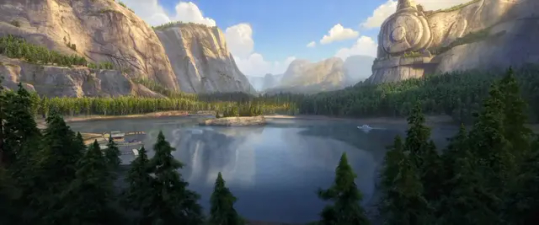
Most all of the rock that you see in these images is granite or granodiorite. That's a hell of a lot of cooled magma, well over 100 square kilometers of it. And due to the course-grained nature of the rock, all of it should have originated as huge, underground magma chambers that cooled slowly over tens of thousands of years.
So...how did it get to the surface?
The short answer is regional uplift. Most of the solidified magma (AKA "plutons") was emplaced during the Triassic, Jurassic and Cretaceous periods. Much later, during the Neogene period, new tectonic forces caused blocks of the now mostly-solid Sierra Nevadas (and the underlying igneous rocks) to rise upward. This exposed the rocks to greater amounts of wind and water erosion. Westward-flowing streams, especially, began to carve down through the rock creating deep, v-shaped valleys. Many times these rivers cut down a LOT faster than their "tributaries" (the smaller streams that flow into a larger one), creating "hanging valleys" and waterfalls. The waterfall at Augerin Canyon is an excellent example.

Other interesting features:
Desquamation (essentially, "removing or loss of scales"):
Remember how all this rock used to be deep underground? Once all of the overlying rock and sediment (collectively "overburden") was removed, the rocks were exposed to surface pressures, and began to to depressurize, breaking along curved fractures, creating an onion-skin like appearance to many exposed rock surfaces.

Image above: Desquamation on granite in Ancient Yosemite.*
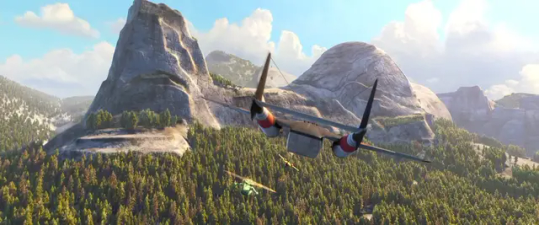


Images above: Desquamation on modern Canopy Dome, Piston Peak and on the canyon walls near the park entrance!
Bonus Cabbie butt for...aesthetic reasons.
*Bonus geology--not igneous related*
Another thing you'll also notice in PPNP is that large swaths of rock appear to have been smoothed out. While you could chalk this up to animators not having the time/budget to render "accurate" rock texture, this type of erosion is VERY common in mountainous areas that have been affected by glaciers. A "Glacier" is channelized ice that flows downhill under its own weight. As the ice descends, it picks up sediment, everything from boulders to clay, and then drags it over the topography. Rugged crags are rounded or carved into sharp blades or spires (if they weren't covered), and v-shaped canyons and valleys take on U-shaped profiles (check out the group shot below).


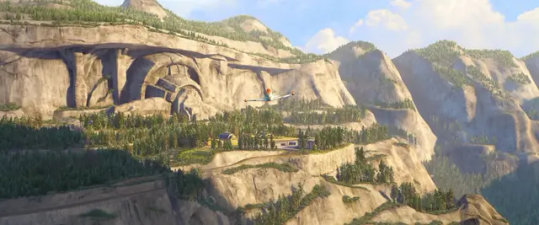
I'm certain that if we zoomed in on some of the exposed rock, we'd also see "glacial striations" and/or "glacial polish," where the rock was scratched and/or polished by the sediment laden ice.

There's also some cool, structural stuff going on elsewhere in the park (Thunderbolt Bluffs and Rail Ridge...), but we'll discuss them in a future essay.
Ok, back to igneous stuffs...
Hot springs and Geysers:
Hot springs and geysers (collectively called "geothermal" features), are manifestations of volcanic activity. They form when groundwater, heated by magma or hot rock deep under ground, reaches the surface. A geyser differs from a hot spring in that the heated water flashes to steam and explodes upward in a stunning spray of steam and mist. Gasket Geyser is one such example.

The only feature in the park that appears out of place is Piston Peak, itself.

Piston Peak is a combination of two, different geologic landforms: a "hoodoo" and an "arch." Unfortunately, these delicate features require specific conditions to form: Variation in rock type (usually layered, sedimentary rock) and minimal moisture. The rocks in and around V6 valley are similar enough, compositionally and structurally, that they erode in a more uniform way compared to, say, the rocks in Monument Valley. Furthermore, there's quite a bit of water present in PPNP, flowing as rivers, and falling as rain or snow. Ice that forms within a crack or fracture can actually wedge the rock apart over long periods of time, a process called "frost wedging." Combined with desquamation, and Piston Peak should have been reduced to a pile of rubble within a few centuries. The same holds true for the arches inside Augerin Canyon (below). They're simply much too delicate to exist in a climate with severe winters that can dump as much as 15' of snow during a single event.
It is possible that these features were carved from existing features to accent their natural shapes, but since we don't have any canon evidence for that, such an assumption falls withing the realm of conjecture/headcanon.

That's all I got for now. Stay tuned for WOC Geology Part 3: Sedimentary Rocks.
Cheers!
Praxyw
#cars fandom#pixar cars#cars#cars pixar#disney cars#disney pixar cars#cars 2006#cars headcanons#planes fandom#planes fire and rescue#disney planes#planes#pop culture geology#geology#rocks#cool rocks#volcanoes#geology in cinema#yosemite#yosemite national park#national park#piston peak national park#piston peak#gasket geyser#glacier#sierra nevada#cabbie#dusty crophopper#blade ranger#granite
50 notes
·
View notes